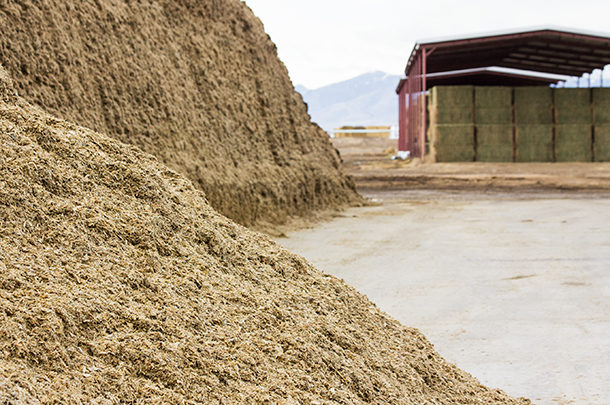Watch the heat
You should frequently monitor stored silage to make sure it isn’t heating up, especially as temperatures start to rise in the summer months. Using a compost thermometer to check for hot spots, probe several areas throughout the bunker to ensure the silage doesn’t heat more than 15°F from the day it was packed.
If one side of the bunker is heating up, use more feed from that area to fix the issue before it becomes a bigger problem. Make sure to mix silage from different areas to maintain a palatable, consistent and nutritious diet. However, if you take more feed from one area, continue to manage the face of the entire bunker to avoid having too much surface exposed.
Additionally, using inoculants containing appropriate strains of Lactobacillus buchneri can help limit heating issues.
Check the covers
Monitoring the bunker externally is just as important as internal checks. Regularly examine the bunker covering for rips or holes, as well as replace tires and sand bags that have been moved or lost. A properly covered bunker seals out air, which can spark aerobic fermentation, bunker heating and loss of valuable nutrients.
Quality feed entails several steps to ensure proper packing density at harvest and management through feedout. Preserving forages on both the front and back end of fermentation is important to boosting your bottom line and ensuring quality feed for livestock.
Arrange overlapping sheets of plastic in a way that covers the forage while ensuring water runoff does not come in contact with the silage. Putting uniform weight on the sheets over the entire surface of the bunker is an effective way to anchor the overlapping sheets while limiting oxygen intake into the silage. Barriers or temporary fencing will also safeguard against domesticated or wild animals eating the forage. Avoid the use of discarded tires, as they are cumbersome and messy. In addition, standing water in these tires offer a breeding ground for disease-carrying mosquitoes.
Up to 45 percent of the nutritive value from the top 3 feet of silage is lost if a bunker is left uncovered, resulting in lost feed and lost money. Implementing management strategies such as inoculation, better compaction and improved face management reduces nutrient shrinkage and saves money.
When looking at packing, experts suggest an average packing density of 15 pounds or better of dry matter per cubic foot. A density of 17 dry matter pounds potentially saves another 1.5 percent dry matter from oxygen penetration. When dry matter is diminished, it must be replaced by an energy source such as cornmeal. Spreading layers 6 inches or less across the bunk is optimum, but if you are unsure about packing weight, use the rule of 800: Multiply the number of tons coming in each hour by 800 to get the total pounds of tractor weight needed for packing.
Make sure to protect silage quality by keeping the silage face clean. Don’t gouge the face of the silage with a front-end loader; rather, remove the forage with equipment that minimizes fractures and oxygen penetration. An average bunker silo loses 15 percent of its dry matter mass during storage and feedout. Good packing, a quality inoculant, appropriate bunker covering and using a defacer can lower losses to 10 percent or less.
Look out for mold
Problems with mold and mycotoxin begin in the field, so monitor often to avoid issues. Although the presence of visible ear molds does not correlate well with mycotoxin contamination, estimates show plants prior to harvest and ensiling contain 70 to 90 percent of all mycotoxin. Virtually everywhere, mold spores easily survive over winter in soil and plant residues.
These field fungi do not typically grow in the anaerobic, low-pH environment found in well-managed silages. However, producing additional toxins in the storage structure can still occur. If crops are heavily laden with yeast, they may consume lactic acid and thus elevate silage pH. If excess oxygen penetrates the high-pH silage, conditions become conducive for field fungi growth in the storage structure.
Confirming mycotoxin as the culprit responsible for production and health problems can be challenging. Sampling the feed after it has been blended in a TMR mixer is the best approach for estimating actual toxin intake from questionable forage or grain. This approach provides a more homogeneous sample compared with traditional methods of sub-sampling composited random samples taken from across the face of the storage structure.
Enzyme-linked immune stimulant assay tests rapidly and inexpensively screen for grain toxins but are prone to many false positives when used on forage samples. Generally, the use of a laboratory that provides chromatography approaches is the best approach. Some nutritionists contract with a mycology laboratory to have silage fungi isolated and identified. If the isolated fungi produce toxins, they can become a plausible causative agent, whether or not random feed sampling detected the actual presence of a toxin.
Work with your nutritionist to decide on a practical approach to remediation of detected toxins. Some options include separating the spoiled feed, attempting to neutralize the toxins or stimulating the immune system of the cattle through increasing proteins, vitamins and minerals. The most effective remedy may be diluting the solution. This is much easier to accomplish on farms with multiple storage options for isolating problem silages, rather than ensiling all the forage in one or two large bunkers. ![]()

-
Matt Laubach
- Dairy Account Manager
- DuPont Pioneer
PHOTO: As summer temperatures increase, hot spots and mold may form in the bunker. Carefully manage the bunker during feedout to deliver quality feed to the cows. Photo by Lynn Jaynes.











